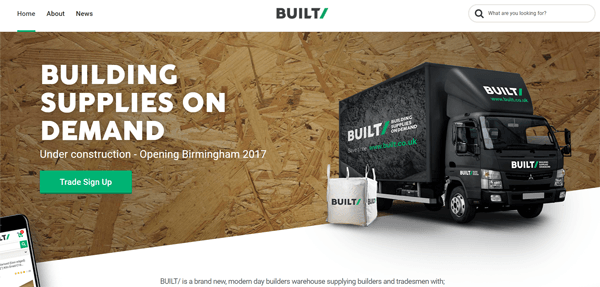Vendor Selection for Digital-First & Start Small, Grow Fast Approach

New companies can be the envy of every industry, as they can create a business model that meets the expectations of modern consumers and build their technology portfolio from the ground up - not being held back by legacy processes or systems.
This spring, BUILT/ launched its company and announced it will be running its entire business on NetSuite's unified cloud commerce platform. According to BUILT/, it aims to make it quicker and easier for professional builders to source materials for their projects, placing a greater focus on providing a superior brand experience with a digital-first approach designed around the customer - certainly positioning itself to be a "disruptor" in its industry.

With enviable agility, Website Magazine reached out to BUILT/ to understand more about its business model, vendor selection, and digital first and smart small, grow fast approach.
What digital capabilities will your clients have that traditional companies in your space do not offer?
Nick Thomas, CEO of BUILT/: We want to make it possible for general builders and professional tradesmen to research, source and service their building supplies needs by providing accurate, consistent, reliable information on price, inventory and customer records across any channel and at any time. In the traditional merchant space, even price is not visible to the customer. Each building supplies purchase - covering price, availability and delivery - is typically negotiated face to face or over the phone or in person at a trade counter so building a proposition that offers all of that in a digitally accessible way ought to be very appealing to our trade customers. We will offer the tradesman the ability to schedule their order for building materials for collection or delivery at specific times / windows focusing on consistently and reliably giving them choice of time that suits them and they can trust rather than on simply promising to deliver as fast as is possible.
What are some expectations you anticipate your B2B customers having and how did those help frame your vendor selection?
Thomas: Increasingly our customers crave consistency and transparency: consistency of information, availability of stock and of service level; and transparency in price, range and customer record information. These are all very hard for the traditional builders' merchant model to deliver because of legacy supply chain issues, various disparate systems, and entrenched operating practices. We knew we needed a system that could house all of that information centrally, was flexible enough to build new business processes around but was also scalable enough to put together an uninterrupted investment case. NetSuite's cloud based ERP and omnichannel commerce platform was a great fit and basis for delivering against the expectations of the builder from the very start. NetSuite's SaaS model and partner network also helps future proof the platform.
How does your new business address consumer demands for on-demand services?
Thomas: We have three primary transaction paths for customers: (1) they can walk-in and order for collection in real-time, (2) they can order for a scheduled collection slot that suits them at some point in the near future, (3) or they can order for their heavy building materials or trade project needs to be delivered to a location and at a time slot that suits them. Our model and business process will ensure we remain in stock in depth at all times so we believe we will be able to consistently and reliably meet the promises we make about when and where customers demand their order. The technology stack we have put together allows us to present those services and information across channels consistently and accessibly anywhere and anytime.
With NetSuite, what type of insights will your internal team have about your clients/customers and how will that (1) help provide a seamless customer experience for the end-user and (2) help your internal team meet their sales, customer service and/or marketing goals?
Thomas: The centrally held data structure will facilitate providing consistent information to the customer regardless of which channel they choose to use, where they access it and when they use it. We will have an end to end view of performance across multiple dimensions and have access to that in real-time giving us the opportunity for actionable insight and optimization. We hope to reduce the fault or failure rate for customers and improve their overall purchasing experience as a result. The greater insight should also allow us to improve how we communicate with customers.
Were there any capabilities that other vendors you looked at had that you wish you could cherry pick and bring to NetSuite?
Thomas: NetSuite was the best overall match for our needs and stood alone on the key requirements for scalable single database architecture.
What were some of the top reasons your company ultimately chose NetSuite?
Thomas: We were looking for a system that allowed our proposition to be presented to the customer with consistency, transparency and ease and that was flexible enough to design a new customer-driven business proposition around. NetSuite's single database architecture meant we could access the product, customer and transactional data uniformly and present the information back quickly across channels. The cloud-based SaaS platform means we can scale the business quickly once we have a proven operating model without needing to re-engineer too many components. We found that NetSuite's SuiteCloud Developer Network with its Built for NetSuite accreditation model was also a key strength providing a natural community of integrated solution-providers who are market-driven to solve for future needs as they arise. Finally, having our holistic business systems requirements supported by one integrated solution provider on a common upgrade path was also very appealing in a rapidly evolving world.
In what ways is your company starting small and anticipating to grow fast?
Thomas: Although we are starting off by focusing on getting the operating model working in one single branch, we have very much designed the systems and processes to roll out to multiple sites. We will have to take advantage of network effects and supply chain efficiencies as we grow because the supply chain for heavy building materials has many challenges. We will modify and amend the business based on the real world customer and operational feedback we get whilst still at a level of scale and complexity that we can manage those changes. We want to put ourselves in a position that the technology can scale in a quick and repeatable way once we want to accelerate.
Continue reading:
- Which Comes First in Digital Transformation, the Partner or the Software?
- Big Picture: Getting Your E-Commerce Business Onto A Global Stage








